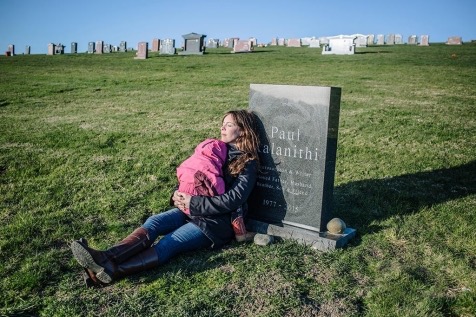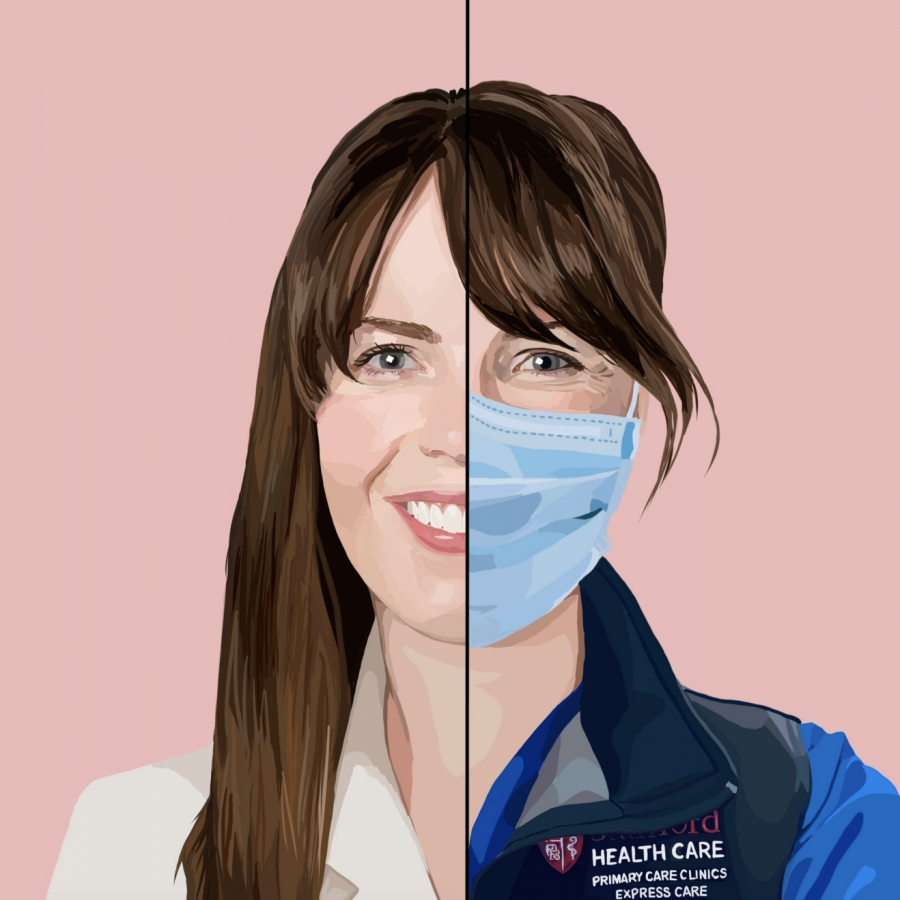Behind the Mask: Dr. Lucy Kalanithi
Dr. Lucy Kalanithi is a Clinical Associate Professor of Medicine at Stanford University. Staff illustration: Grace Tang.
May 24, 2020
Staff Illustration by Grace Tang.
Behind the Mask is a series exploring the lives of five medical professionals and how their lives have changed because of coronavirus. This is part one of five, a profile on Dr. Lucy Kalanithi, Clinical Associate Professor of Medicine at Stanford University.
———
In the midst of the coronavirus pandemic, the lives of doctors worldwide have become more complicated, and not just because they are treating patients with a highly infectious disease. Clinical Associate Professor of Medicine at Stanford University Dr. Lucy Kalanithi, who has been working at Stanford since 2014, has had to adapt in more ways than one, from wearing masks at work to balancing her personal life with a demanding workload to thinking about the potential moral distress that the pandemic could put her in.
Kalanithi is a primary care doctor and usually sees 20 patients a day who have any sort of symptoms or health concerns. The clinic she works in functions similar to an urgent care center, meaning she only sees patients with same-day appointments. Now, every patient Kalanithi sees either has coronavirus or is concerned that they might have it.
The onset of coronavirus has prompted Kalanithi and others in the medical community to find creative ways to tackle the problem. For example, she has gotten back in touch with the doctors she did residency, a stage of medical training, with via WhatsApp, a messaging app. The original purpose of the thread, which includes around 40 doctors who work in various parts of the U.S., was for emotional support. “It’s the doctor equivalent of calling home in an emergency,” Kalanithi said. The WhatsApp thread has also become a place where they share information and protocols.
In addition, Kalanithi is learning a lot about the coronavirus from the Twitter hashtag, #medtwitter. “Everyone is learning in real time and then sharing what they’re learning,” she said.
The pandemic has also contributed to the rise of telemedicine. According to Kalanithi, most appointments in her clinic since the beginning of coronavirus have been over video. “The whole set up is extremely different,” she said.
Stanford has mandated that all medical personnel wear procedure masks anywhere in the clinic and do a daily temperature check at the building entrance. When treating coronavirus patients, doctors wear full N95 masks, gowns, eye shields, hair covering and gloves. According to Kalanithi, some doctors have taped photos of themselves without their masks to their scrubs to help put patients at ease. “With our colleagues and all other patients, social distancing isn’t always possible. We can’t always stay six feet away from each other in a hospital or clinic,” Kalanithi said. Though there is a worldwide, critical shortage of personal protective equipment (PPE), Stanford keeps doctors updates and still has weeks of supplies left, according to Kalanithi.
The coronavirus has brought significant changes to Kalanithi’s personal life. She has a 5-year-old daughter and usually drops her off at school, then sees her again for dinner and has time to do work at home. Now, she’s either at work or at home and finds herself staying up late to get extra work done. “It’s been really intense, but it’s also the most satisfying, interesting thing I’ve ever done in my medical career,” Kalanithi said. “I look around at my [colleagues] and I feel like we’re the grownups. We have to figure it out,” Though she mentions having felt this on an individual level in the past, such as with patients or when doing a medical procedure she’d never done before, it’s amplified in the presence of the pandemic.
Kalanithi is slighly scared of getting coronavirus, but given that she and her daughter are healthy and that it doesn’t tend to affect people in their age groups significantly, she is more concerned for her parents and others who have a higher chance of contracting the virus.
She is the most anxious about the moral aspect of the pandemic, as it could overwhelm the healthcare system. According to Kalanithi, the reason why everyone is sheltering in place is because if everyone contracts coronavirus at once, there won’t be enough hospital beds or ventilators. In some places, like Italy, doctors can only answer calls for an ambulance if the patient is in critical condition and must leave some behind. Some doctors have been comparing this to having to participate in a real-life “trolley problem.” The trolley problem is a thought experiment that discusses what to do if there’s a trolley that’s about to kill five people as opposed to one if the person makes the decision to divert it. “Some feel as if they have to decide who lives and who dies! It’s something we aren’t trained for and that prospect was keeping me up at night,” she said.
Five years ago, Kalanithi’s husband, Dr. Paul Kalanithi, a neurosurgeon and author of “When Breath Becomes Air,” passed away from terminal lung cancer. “People always said, ‘Don’t you think it’s unfair?’ and I never thought so. It was wildly unlucky. Getting terminal cancer is not morally distressing, but this [pandemic] is. It’s straining our health care abilities and it’s even worse for people of color and for people in nursing homes, homeless shelters and prisons,” Kalanithi said.

Kalanithi mentioned a viral photo she saw online, which showed two doctors in full PPE, holding up a sign. “We came to work for you, you stay home for us,” the sign reads.
“Especially for high school students, not being able to be social is hard. I want to say thank you to everybody for staying home,” Kalanithi said. “It’s really going to save many, many lives, and it’s the reason that we will have enough equipment in California to treat anybody who does get sick.”




